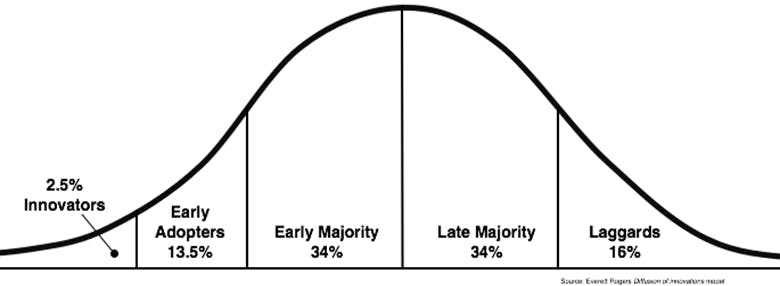
This past week, the VectorCare team was able to present at Pinnacle EMS’s Webinar series on the evaluation and adoption of new technologies in healthcare organizations.
We’ll be sharing a recording of the webinar soon (so stay tuned!), but in the meantime, here are a few of our most important tips for evaluating and adopting new technologies in your organization. This advice is based on dozens of interviews with industry experts from our podcast, THE PATIENT’S JOURNEY.
Evaluation
This stage in the buying process occurs once you’ve isolated your technology options to 2-3 possible solutions and are comparing to see which solution is best.
Start by performing a current systems analysis. What are you currently doing now in place of the new solution? For example, if you’re looking to purchase an online credentialing tool, your “current system” may take the form of an employee faxing and filing paper credentials and tracking expiry dates in a spreadsheet. Estimate the total cost of the current way of doing things, so that you have a benchmark to compare your solution with.
Consider the long-term outlook of your solutions. Where do you want your business to be in 5 years? 10 years? Where is the healthcare industry trending toward? Try to narrow your solutions down to options that will scale with the healthcare industry as well as your business goals. One example here is looking for FHIR data standards when purchasing software, as FHIR is becoming more and more widely used for data exchange and interoperability in healthcare.
Next, you’ll want to do a detailed breakdown of each solution’s cost, features, vendor partnership, and more. WE’VE CREATED A FREE RESOURCE HERE for all readers in order to help evaluate solutions. Simply download the template and fill it out for each individual solution, giving you a standardized comparison chart.
Adoption
Once you’ve isolated which technology solution you’d like to purchase, your organization can move to the “adoption” phase. This can be the most challenging stage in technology transformation: gaining staff buy-in and successfully training your employees to use the new technology. However, by tailoring your adoption process for individual subsets of employees, you can set your team up for a successful adoption.

Most commonly used for marketing, the Diffusion of Innovation curve explains different groups of people’s willingness to adopt new technologies. While the exact percentages of each of the five groups may differ in your organization, you will have individuals from each group. The 5 groups are:
Innovators: Individuals who are the most willing excited to innovate and embrace new technology.
Early Adopters: Staff who show strong interest in new technology, but aren’t the forerunners to drive change.
Early Majority: A large percentage of your staff who, while not extremely enthusiastic about change, will be pretty amenable to new innovations. If you can win this group over, you’ll reach the tipping point within your organization and the adoption can go pretty smoothly from there. You’ll reach both the early and late majority when you roll out the new technology to the entire staff, but individuals in the early majority will pretty quickly jump on board and work collaboratively to develop best practices.
Late Majority: The late majority will typically resist new technology without encouragement and/or proof of it’s efficacy.
Laggards: This group is most resistant to change, and may only adopt it once they are forced to. This group is also the most vocal complainers.
In order to have the most effective adoption process possible in your organization, it’s important to design a training and adoption framework that caters to each individual group. Below are some suggestions:
Innovators/Early Adopters: Give this group first access to the technology, and encourage them to even help in the evaluation process. This group is also extremely useful as focus groups or to test out training materials.
Early Majority: If you’re able to get this group onboard, the rest of your organization will follow suit. Before requiring this group to use the technology, make sure you have the implementation set up and running as seamlessly as possible: troubleshoot possible bugs and set up training documentation. Consider offering incentives to this group for adoption and to help establish best practices.
Late Majority: In order to demonstrate the value of the new technology to this group, make sure your adoption plan includes key metric tracking from the outset. The Late Majority is far more likely to be convinced with clear ROI and performance metrics.
Laggards: The Laggards may never be excited about changing to new technology, but you can set up clear channels of communication for any complaints or concerns. This will help them feel heard and valued throughout the process, rather than voicing their concerns to other employees.
Training Tips
A successful adoption plan will cater, in some form or another, to all the above groups. However, there are still some tips that our experts recommend specifically for the training stage.
- Teach technology one-on-one if possible, rather than in group settings. This allows for concentrated 2-way dialogue between staff and trainer, and avoids group dynamics. It also provides a better environment to confirm if the staff member is actually learning the new system.
- Provide multiple training methods. Everyone learns differently. If possible, offer multiple training methods to staff (video trainings, PDFs, in-person training, etc).
- Consider offering staff “exams” focused on skill competency. Just because a new technology is rolled out in your organization does not mean that staff will learn how to use it effectively, which can be problematic in care delivery settings. Set a training standard that all staff must reach, then require competency exams for staff.
To end our training advice, we’d like to showcase this quote from Chris Cebollero, the bestselling author and Chief of EMS for Christian Hospital:
"We've got to be able to invest in our people. People who are doing the job. The true measurement of success of our organization is how engaged, satisfied, and productive our workforce is. They've got to be able to have the skills, knowledge, and experience to deliver the highest quality of patient care. As leaders in healthcare, we can't just give our staff new tech tools and say "have at it". We have to take responsibility for their training."
For a complimentary tech evaluation guide and our free credentialing app for healthcare professionals, CLICK HERE.
Similar resources

Ambulance Providers as Patient Logistics Centers: Reimagining Community Healthcare Coordination


